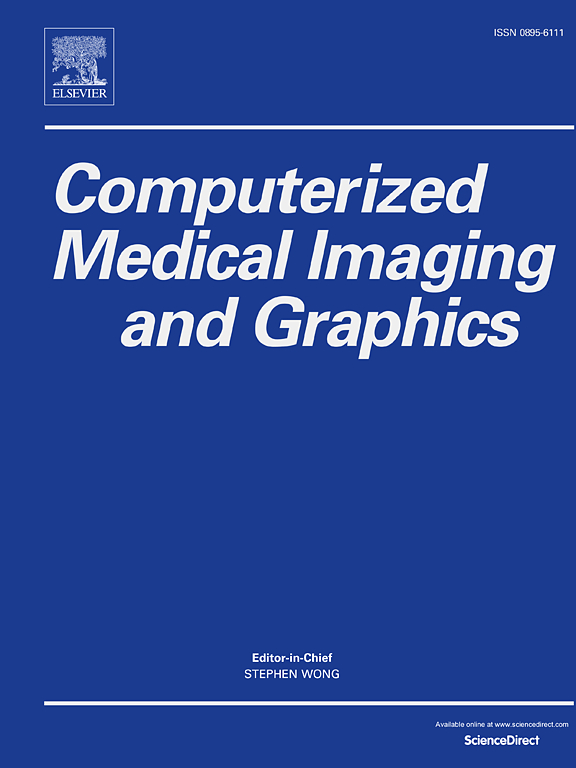RibFractureSys:诊断急性肋骨骨折的瑰宝。
IF 5.4
2区 医学
Q1 ENGINEERING, BIOMEDICAL
Computerized Medical Imaging and Graphics
Pub Date : 2024-10-01
DOI:10.1016/j.compmedimag.2024.102429
引用次数: 0
摘要
肋骨骨折患者是创伤病房的常见病,其死亡率和合并症因肋骨骨折的数量和部位而异。因此,这些知识对于做出准确预后和优先护理病人至关重要。然而,对放射科医生来说,在病人扫描的 200 多帧图像中追踪 24 根肋骨既费时又容易出错,尤其是根据他们的经验。我们提出了一种自动化、模块化、三阶段的解决方案来帮助放射科医生。我们使用 9 张完整标注的患者扫描图像,训练了一个多类 U-Net 来分割肋骨病变和常见的解剖杂波。为了识别肋骨骨折并减少误报,我们利用 5698 例误报、2037 例急性骨折、4786 例愈合骨折和 14904 例未骨折肋骨病变对基于 ResNet 的模型进行了微调。利用近 200 例患者,我们开发了高度任务定制化的多对象肋骨病变追踪器,以确定一帧图像中的哪些病变属于两侧 12 根肋骨中的哪一根;我们采用了基于联合和中心点追踪的边界框交叉、线交叉方法和各种启发式方法。我们的系统接受轴向 CT 扫描,并对扫描结果进行处理、标记和颜色编码。在一个包含 1000 名急性肋骨骨折患者和 1000 名对照组患者的内部验证数据集上,我们的系统在一名 3 年放射科住院医生的评估下,对肋骨骨折患者和对照组患者的骨折分类正确率分别达到了 96.1% 和 97.3%。但是,在这些患者中,分别有 18.0% 和 20.8% 的肋骨标记不正确。不同性别和年龄人口的百分比保持一致。标注问题包括解剖杂乱的肋骨被误标为肋骨和肋骨未被标注。本文章由计算机程序翻译,如有差异,请以英文原文为准。
RibFractureSys: A gem in the face of acute rib fracture diagnoses
Rib fracture patients, common in trauma wards, have different mortality rates and comorbidities depending on how many and which ribs are fractured. This knowledge is therefore paramount to make accurate prognoses and prioritize patient care. However, tracking 24 ribs over upwards 200+ frames in a patient’s scan is time-consuming and error-prone for radiologists, especially depending on their experience.
We propose an automated, modular, three-stage solution to assist radiologists. Using 9 fully annotated patient scans, we trained a multi-class U-Net to segment rib lesions and common anatomical clutter. To recognize rib fractures and mitigate false positives, we fine-tuned a ResNet-based model using 5698 false positives, 2037 acute fractures, 4786 healed fractures, and 14,904 unfractured rib lesions. Using almost 200 patient cases, we developed a highly task-customized multi-object rib lesion tracker to determine which lesions in a frame belong to which of the 12 ribs on either side; bounding box intersection over union- and centroid-based tracking, a line-crossing methodology, and various heuristics were utilized. Our system accepts an axial CT scan and processes, labels, and color-codes the scan.
Over an internal validation dataset of 1000 acute rib fracture and 1000 control patients, our system, assessed by a 3-year radiologist resident, achieved 96.1% and 97.3% correct fracture classification accuracy for rib fracture and control patients, respectively. However, 18.0% and 20.8% of these patients, respectively, had incorrect rib labeling. Percentages remained consistent across sex and age demographics. Labeling issues include anatomical clutter being mislabeled as ribs and ribs going unlabeled.
求助全文
通过发布文献求助,成功后即可免费获取论文全文。
去求助
来源期刊
CiteScore
10.70
自引率
3.50%
发文量
71
审稿时长
26 days
期刊介绍:
The purpose of the journal Computerized Medical Imaging and Graphics is to act as a source for the exchange of research results concerning algorithmic advances, development, and application of digital imaging in disease detection, diagnosis, intervention, prevention, precision medicine, and population health. Included in the journal will be articles on novel computerized imaging or visualization techniques, including artificial intelligence and machine learning, augmented reality for surgical planning and guidance, big biomedical data visualization, computer-aided diagnosis, computerized-robotic surgery, image-guided therapy, imaging scanning and reconstruction, mobile and tele-imaging, radiomics, and imaging integration and modeling with other information relevant to digital health. The types of biomedical imaging include: magnetic resonance, computed tomography, ultrasound, nuclear medicine, X-ray, microwave, optical and multi-photon microscopy, video and sensory imaging, and the convergence of biomedical images with other non-imaging datasets.

 求助内容:
求助内容: 应助结果提醒方式:
应助结果提醒方式:


